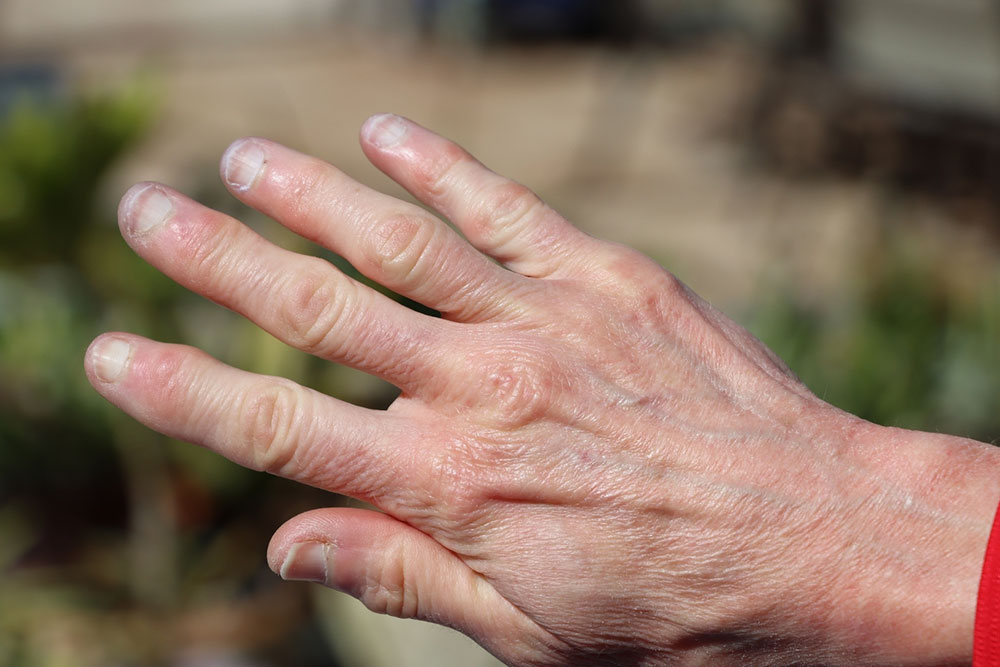Symptoms and Management Options for Heberden’s Nodes
Osteoarthritis of the hands is very common. Statistics suggest that about one in four men develop it by age 85. Bony swellings near the fingertips, also called Heberden’s nodes, are the primary symptom of this condition. The nodes usually form on the distal interphalangeal joints when the spongy cartilage that cushions them wears out due to constant usage.

Symptoms of Heberden’s nodes
The symptoms discussed below point toward Heberden’s nodes. Those who experience them should visit a healthcare provider to determine the cause and start the treatment as soon as possible.
- Bony swellings
Heberden’s nodes appear as firm, bony swellings on the distal interphalangeal joints. These nodes are often palpable, meaning one can touch and feel them. In appearance, they look like pea-sized bumps or larger protrusions on the fingers. The extent of swelling is based on the severity of osteoarthritis. Initially, it starts as a slight swelling or enlargement and then progresses with continued wear and tear of the joint. The size of these nodes may vary among patients, and the level of swelling on each finger may also differ. - Pain and tenderness
As the condition advances, individuals with Heberden’s nodes may experience tenderness and pain in the affected joints. They may complain of stabbing pain and dull to sharp aches that may worsen when applying pressure on the fingers or moving them. Grasping, gripping, or repetitive hand motions may worsen the discomfort. These activities might even exacerbate the tenderness in the joints and nodules. - Stiffness
Another notable sign of Heberden’s nodes is stiffness and a limited range of motion of the fingers. The patient’s fingers become less flexible, so they have difficulty fully extending or straightening them. This symptom makes daily tasks like writing, chopping, cooking, typing, or buttoning clothing challenging. Generally, the stiffness is most noticeable following periods of inactivity, like after waking up in the morning. However, gentle movement and stretching can help ease this problem.
Those with Heberden’s nodes may also experience symptoms like redness and inflammation, which increase in severity as osteoarthritis progresses.
Treatments for Heberden’s nodes
There are several ways to manage the condition better and relieve the symptoms. While some popular options are listed below, one should consult a doctor to determine the best treatment for Heberden’s nodes in their case.
- Pain management
One of the most crucial aspects of dealing with Heberden’s nodes is managing pain. The pain and discomfort caused by the condition can significantly impact one’s daily activities. Therefore, doctors prescribe several treatments to alleviate pain and manage the increased levels of inflammation in the body. The treatments health practitioners prescribe can help manage mild to moderate pain. However, patients should stick to the prescription and use the treatment as the doctor suggests. If the discomfort or pain does not improve, one should speak to the expert about other treatment options for pain associated with Heberden’s nodes. - Joint protection
Protecting the finger’s joints is important to minimize the stress and inflammation they face. It also reduces the risk of joint damage in the future. Doctors might ask patients to wear splints or braces on the affected fingers for support and stability, particularly during activities involving repetitive movements or joint strain. Occupational therapy can also come in handy. The practice trains patients with Heberden’s nodes to protect their joints while performing daily tasks. It also focuses on using ergonomic tools and assistive devices and modifying activities to reduce joint strain and keep the symptoms from worsening. - Physical therapy
Physical therapy is among the most valuable Heberden’s node treatments. It teaches patients exercises and movements to strengthen the muscles, improve joint flexibility, and enhance joint function. Physical therapy sessions may also include manual therapy techniques, such as joint mobilization or soft tissue massage, to alleviate pain and improve joint mobility. - Heat and cold therapy
Heat and cold therapy is a non-invasive treatment option to deal with pain, discomfort, and inflammation resulting from Heberden’s nodes. Hot compresses, heat packs, or wax baths can help relax the muscles and improve blood flow. They can also decrease joint stiffness. On the other hand, cold therapy can reduce inflammation, alleviate pain, and numb the area using cold water, cold packs, or ice packs. Alternating heat and cold therapy can deliver the desired relief for patients with Heberden’s nodes. - Surgery
If the above options do not work, doctors might suggest Heberden’s node removal with surgery. It is mostly reserved for individuals with severe Heberden’s nodes causing significant pain, joint deformity, or functional impairment. Surgical options include joint fusion or joint replacement procedures to alleviate pain, restore joint function, and improve overall joint stability. Those considering surgery should discuss the potential risks, benefits, and outcomes with their healthcare provider to make an informed decision.











